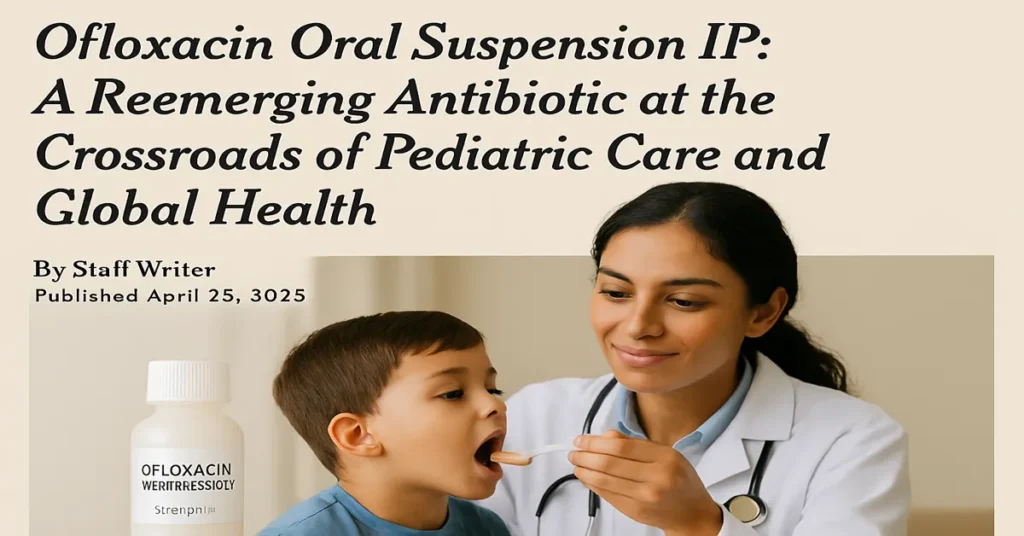In a world where antibiotic resistance has reached a boiling point and global pharmaceutical access remains imbalanced, few medicines stand as both a solution and a subject of scrutiny. One such drug is Ofloxacin Oral Suspension IP—a broad-spectrum antibiotic that, while once controversial in pediatric circles, is re-entering the spotlight with new relevance, regulatory updates, and therapeutic opportunities.
Across developing nations, particularly in India and Southeast Asia, the resurgence of Ofloxacin Oral Suspension IP reflects more than just clinical demand; it embodies a broader narrative: one of affordable healthcare access, precision dosing, and the delicate balance between medical necessity and responsible pharmacology.
In this article, we unpack the layered story of Ofloxacin Oral Suspension IP—from its pharmacological roots to the modern debates around its use in children, and why the world is watching.
A Closer Look: What is Ofloxacin Oral Suspension IP?
Ofloxacin is a fluoroquinolone antibiotic, known for its powerful action against both gram-positive and gram-negative bacteria. The “IP” in its name signifies Indian Pharmacopoeia, the national standard of drug formulation in India. When administered as an oral suspension, the drug is typically intended for pediatric patients or individuals unable to swallow tablets.
But what sets Ofloxacin apart? Unlike older antibiotics like penicillin or amoxicillin, Ofloxacin exhibits broad-spectrum activity against respiratory, gastrointestinal, and genitourinary infections. It targets bacterial DNA gyrase and topoisomerase IV, crucial enzymes for bacterial replication, rendering it lethal to pathogens while largely sparing human cells.
Historical Use and Controversies in Pediatric Medicine
Ofloxacin made its debut in the 1980s, initially hailed as a major step forward in antibiotic therapy. However, early post-marketing surveillance revealed a troubling side effect profile when administered in juvenile animal models, particularly in weight-bearing joints. This prompted regulatory bodies like the FDA and EMA to issue strong cautions or outright restrictions on pediatric use.
Despite those concerns, countries like India continued to prescribe Ofloxacin for children—particularly in the form of Ofloxacin Oral Suspension IP, arguing that clinical necessity in high-infection, low-resource environments outweighed the risks. For example, cases of persistent bacterial diarrhea, typhoid fever, or resistant respiratory infections frequently justified its use when alternatives failed or were unavailable.
Today, the WHO acknowledges Ofloxacin on its Model List of Essential Medicines, albeit with a nuanced caveat: “reserved for specific indications and under clinical discretion.”
2025 Regulatory Shifts and Renewed Interest
As of 2025, several Indian pharmaceutical watchdogs have issued revised pediatric guidelines that cautiously permit Ofloxacin oral suspension under strict diagnosis-specific frameworks. The shift follows decades of real-world observational data from Asia and Africa showing relatively safe outcomes when used at correct dosages and durations.
Key highlights of the new guidelines:
- Indicated only for children above 2 years of age.
- Course limited to 5-7 days unless otherwise indicated.
- Must be prescribed by a registered pediatrician.
- Use should follow bacterial culture and sensitivity tests wherever feasible.
This cautious green-lighting is part of a broader decentralized antibiotic stewardship initiative, aiming to curb resistance without denying treatment.
Pharmacokinetics and Dosing Considerations
Ofloxacin, when administered orally, is rapidly absorbed with nearly 98% bioavailability. The oral suspension form allows for accurate weight-based dosing, especially important in pediatric patients. The typical formulation in India is 50 mg/5 ml, with dosing around 7.5–15 mg/kg/day, divided into two doses.
The medication reaches peak plasma concentration within 1–2 hours and exhibits excellent tissue penetration—particularly in the lungs, intestines, and urinary tract—making it suitable for multi-organ infections.
However, due to partial metabolism by the liver and significant renal excretion, dose adjustments are essential in patients with hepatic or renal dysfunction.
Ofloxacin Oral Suspension IP in Real-World Clinical Practice
Dr. Poonam Sethi, a pediatric infectious disease specialist in Lucknow, notes a growing but cautious acceptance of the suspension among clinicians:
“We don’t use Ofloxacin lightly. But when you have a resistant E. coli case causing gastroenteritis in a dehydrated child, and when ampicillin fails, Ofloxacin is our reliable backup.”
Her sentiment reflects a shift from skepticism to pragmatic usage. The primary infections where Ofloxacin Oral Suspension IP is currently employed include:
- Acute Bacterial Diarrhea: Especially where culture shows quinolone-sensitive E. coli or Salmonella.
- Typhoid Fever: Caused by Salmonella Typhi, especially resistant strains.
- Lower Respiratory Tract Infections: Where atypical pathogens like Legionella or Mycoplasma are suspected.
- UTIs in Adolescents: When culture-confirmed and other safer agents are contraindicated.
Resistance: The Double-Edged Sword
With great power comes a public health dilemma: antimicrobial resistance (AMR). Fluoroquinolones like Ofloxacin are often implicated in rising resistance patterns, especially in urban India, where over-the-counter access remains loosely regulated.
The 2024 National AMR Surveillance Report from India showed alarming resistance rates:
- E. coli: 42% resistance to Ofloxacin
- Klebsiella pneumoniae: 31%
- Salmonella Typhi: 16%
The numbers underscore the importance of restricting Ofloxacin’s use to lab-confirmed bacterial infections, not viral or presumed illnesses.
To address this, pharmacists across major Indian cities are now mandated to record prescriptions electronically and limit sales of antibiotics like Ofloxacin to those with proper documentation.
Read: TravelsForNow.com: The Ultimate Guide for Modern Explorers
The Organic Chemistry of Ofloxacin: Simplicity with Precision
Chemically, Ofloxacin belongs to the second generation of quinolones, with a chiral center that exists as a racemic mixture. Its molecular formula is C18H20FN3O4. The drug’s synthetic pathway is relatively low-cost, enabling large-scale production in Indian pharmaceutical hubs like Gujarat and Himachal Pradesh.
Recent manufacturing innovations have yielded nano-suspension versions of Ofloxacin, enhancing absorption and potentially lowering the required dose—thereby minimizing side effects.
Side Effects and Black Box Warnings
Despite its efficacy, Ofloxacin is not without risk. The most commonly reported side effects in children include:
- Gastrointestinal upset: Nausea, vomiting, abdominal cramps.
- CNS symptoms: Headache, dizziness, or rarely, insomnia.
- Musculoskeletal issues: Arthralgia or joint discomfort in some pediatric patients.
In rare cases, tendonitis or tendon rupture—a hallmark risk with all fluoroquinolones—has been documented, particularly in those on corticosteroids.
Hence, all prescriptions must be accompanied by parental counseling and follow-up protocols.
Pediatric Formulation and Taste Engineering
One of the lesser-discussed yet crucial aspects of Ofloxacin Oral Suspension IP is palatability. Bitter-tasting antibiotics are notoriously difficult to administer to children, often leading to missed doses or vomiting.
Modern formulations employ:
- Masking agents: Such as sucralose or aspartame.
- Fruit flavors: Mango, strawberry, or orange variants.
- Thixotropic suspensions: To ensure easy pouring without shaking.
These innovations ensure higher compliance rates, especially in children under 5.
Future of Ofloxacin: Novel Applications Under Study
Pharmaceutical researchers in 2025 are exploring Ofloxacin in novel delivery systems:
- Oral thin films (OTFs) for rapid disintegration in the mouth.
- Liposomal suspensions for targeted delivery.
- Combination therapies: Such as Ofloxacin with probiotics, to counter gut microbiota disruption.
Moreover, its role in treating zoonotic infections (in both humans and veterinary medicine) is being reviewed, particularly in rural healthcare models.
Global Implications: Exporting India’s IP Standard
India, as one of the largest manufacturers of generic drugs, plays a key role in supplying Ofloxacin Oral Suspension IP to parts of Africa, Latin America, and Southeast Asia. Indian Pharmacopoeia standards are increasingly seen as globally relevant, especially for nations lacking robust regulatory bodies.
The World Health Organization has encouraged cross-national pharmacopoeial harmonization, where drugs like Ofloxacin Suspension IP serve as case studies for balancing cost, quality, and access.
Final Thoughts: The Tightrope Between Access and Accountability
The story of Ofloxacin Oral Suspension IP is not just pharmacological—it is political, ethical, and deeply human. It speaks to the realities of treating infectious disease in resource-limited settings, where a single well-tolerated antibiotic can mean the difference between recovery and mortality.
Yet it also reminds us that medicine must evolve not just in molecules, but in monitoring, education, and responsibility. Ofloxacin, when used judiciously, saves lives. When abused, it accelerates resistance and erodes trust.
As global health narratives shift from eradicating diseases to managing them sustainably, Ofloxacin stands as both a relic of past optimism and a tool for future precision. In the hands of trained professionals and informed patients, it may yet fulfill its promise—delivering not just treatment, but trust in medicine, drop by drop.







